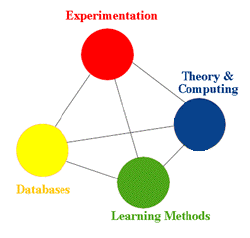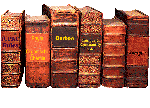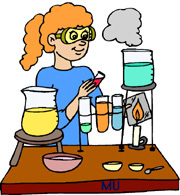| Professor | Dr. Rainer Glaser |
| Office | 321 Chemistry Building |
| Telephone | (573) 882-0331 |
| GlaserR@missouri.edu | |
| Chemistry 212 Course Web Site | http://www.missouri.edu/~chemrg/RG_T_WS03.html |
| Lectures Laboratory Preparation & Active Learning |
MWF 9:00 - 9:50, 126 Physics R 9:00 - 9:50, 126 Physics |
| First Lecture | Wednesday, January 22, 2003 |
| Office Hours | WF 10:00-10:50 |
Course Goals
Organic chemistry is pervasive in every aspect of modern life. Chemistry
is the central science and every science major needs to master chemistry.
Many consumer choices, economic choices and political choices require the
understanding and competent application of chemical concepts. Chemistry
knowledge thus informs both the professional life of a science major
as well as his/her life as good citizen in a democratic society. It is
the goal of this course to teach students the abilities to ...
[1] Learn the (symbolic) language of organic chemistry.
[2] Develop clear conceptual ideas and quantitative knowledge about the sources, properties, reactions and uses of organic chemical materials.
[3] Access online journals and databases and extract information form these sources.
[4] Understand the historical context and the culture of the field of organic chemistry and to judge your own work and the work by others in that context.
[5] Read the contemporary press and media and learn to identify and place in context any issues which require an understanding of organic chemistry for their complete appreciation.
[6] Enable autodidactic behavior - the utopian goal.
|
Aristotle's World
Aristotle (384-322 BC) was very wrong
... we are getting better but beware! |
The Modern World  |
|
Organic Chemistry |
About Learning in Customary Educational Settings
Similarly, no one has been able to confirm any certain limits to the speed with which man can learn. Schools and universities have usually been organized as if to suggest that all students learn at about the same rather plodding and regular speed. But, whenever the actual rates at which different people learn have been tested, nothing has been found to justify such an organization. Not only do individuals learn at vastly different speeds and in different ways, but man seems capable of astonishing feats of rapid learning when the attendant circumstances are favourable. It seems that, in customary educational settings, one habitually uses only a tiny fraction of one's learning capacities. [Emphasis ours]
Excerpt from the Encyclopaedia Britannica
Complexities of Human Learning
Human learning is complex rather than simple. Learners are apt to learn more than one thing at a time. Sometimes this process is conscious, as when one simultaneously or rapidly assimilates many specific items of a whole. More often, the process is entirely or partly unconscious, as when the student learns some "content" consciously but at the same time absorbs unwittingly a great deal more from interrelationships, tones of voice, and so on.
Educators are therefore becoming increasingly concerned with these concomitant learnings. They are aware that the long-term significance of the arithmetical skill that the student consciously learns may be nugatory compared with the importance of what he learns about himself as a learner, about his capacities and limits, about his relationship with his teacher, about power and authority, about his relationships with his fellow students, about equality, collaboration, competition, and friendship. As educators become more knowledgeable about the importance of learning climates, they are impelled to abandon simplified techniques of teaching in favour of a more complex approach that views learning in the context of a matrix of relationships and forces that act upon the student, the teacher, the school, and the community.
Excerpt from the Encyclopaedia Britannica
Course Materials and
Book Adoption Policy
I am recommending two books to you. The text by Carey is the text
currently adopted by the MU Organic Chemistry Divison and this text is
therefore the required text for this course. My course organization
coincides with the organization of the book by Wade and some of you might
find that text helpful as well.
Feel free to use any other text on Organic Chemistry. There is general
agreement among all the books about the core curriculum at this level of
chemistry instruction. Using several books or switching between books
from one course to the next can, in fact, be an advantage. Getting
another perspective is a positive experience. Comparing two texts
emphasizes key areas and diminishes tangential issues.
For the purpose of testing and performance assessment, the course content
is defined by the activities during regularly scheduled meeting times.

Course Materials I. Books and Model Sets.
(1) Required Text & Study Guide:
F. A. Carey, Organic Chemistry w/ CD and Study Guide/Solutions
Manual,
5th eddition, 2003, McGraw-Hill, Dubuque, IA.
ISBN 0074174320.
Cost: $ 150.75
(at MU Bookstore).
(2.1) Recommended Text: Organic Chemistry,
Leroy
G. Wade, Jr.; 5th ed.,
Prentice Hall, Upper Saddle River, New Jersey 07458, 1999.
ISBN 013033832x. Cost: $102.70 (at MU Bookstore).
(2.2) Recommended Study Guide: Study Guide and Solutions Manual for
Organic Chemistry, Jan
W. Simek; 5th ed.,
Prentice Hall, Upper Saddle River, New Jersey 07458, 1999.
ISBN 0130600288. Cost: $52 (at MU Bookstore).
(3) Required Model Set: HGS
Molecular Model Set, C Set for
Organic Chemistry, W. H. Freeman and Company. ISBN 0716748223.
Cost: $32.
Course Materials II. Laboratory Teaching Materials.
Educational materials from various sources will be used in the
laboratory. Some of the materials were developed by faculty of the
Department of Chemistry while other materials are adopted from Chemical Education Resources. For your
convenience, all of these materials are available in electronic
format at the same location along with spectral information, grading
information and so on. A password is required to access these
files and you will be given that password in lecture.
Course Materials III. Resources of the World Wide Web
& The New York Times.
We will make extensive use of the world wide web as instructional tool.
Chemistry is in the News
activities, studies of
Visualization Centers,
explorations of
Web Destinations,
inspections of
Reaction
Animations
all are web based.
As part of the "Chemistry is in the News" project, you are required to
read The New York Times this semester. The New
York Times is the Nation's newspaper and features a superb
science section in its Tuesday edition. In fact, there are many articles
in The New York Times every day that are in some way
related to science in general and chemistry in particular. We want to
learn to see these connections!
In previous semesters, I have frequently based test questions on
NYT articles and I will continue this practice. So, keeping up
with the Times
will be good for your chemistry grade. There are several ways for you to
read The New York Times:
[a] Buy a subscription of The New York Times for $0.40 per
day and pick it up every morning at the General Books Information Desk at
the University Bookstore in Brady Commons. There is nothing like browsing
the hardcopy! Subscription forms for WS03, M-F, 75 issues for $30, will be
distributed in class at the end of the first lecture.
[b] Get your daily copy of The New York Times from one of
the vending machines on campus.
[c] Read the online version of
The New York Times and print out what you like.
Activities
I. Commitment
Chemistry 212 is a demanding course and a clear commitment has to be made.
Merriam Webster's Dictionary defines
com.mit.ment (noun, 1621) as
"a: an agreement or pledge to do something in the future;
especially: an engagement to assume a financial obligation at a
future date b: something pledged c: the state or an instance
of being obligated or emotionally impelled (a commitment to a
cause)."
Four hours of lecture and a four hour lab. For
every hour of lecture, you are expected to spend two hours studying
and you need at least another two hours to prepare and write-up the
laboratory sessions. This means that you are expected to spend 8
hours every week studying for this course IN ADDITION TO the 8
contact hours. So, this course requires 16 hours of your time
every week and this needs to be clear to you from the very start.
And before tests you might want to put in a few extra hours on top of
that. While this course is demanding, it also is very fair in that there
will be clear expectations as to what you need to do. If you invest the
time, you will do well.
Just coming to lecture and putting in a few hours before a test is a
strategy that does not work in chemistry. There have to be a
permanent effort and a planned commitment of time to spend on studying
chemistry. Students often have difficulty with time management and
this is a skill that needs training. Keep a time sheet, for example, and
write down honestly what you studied at what time. "Interruptions" do not
count as study time. We will have a "study habits" module in February.
II. Lectures
Come to class well prepared! Do read the material before it is
covered in class. We want to spend considerable time "talking about
chemistry" in class. After the lecture, read the material again and test
yourself, possibly in small groups. If uncertainties remain, review the
material again, talk to one of the teaching assitants, or come to see me
during office hours.
III. Laboratory
 |
The 4-hour laboratory session constitutes an essential part of Chemistry 212 and ten sections are offered. Experiments will be discussed in the Thursday lecture of the week preceeding the performance of the experiment. For details about the laboratory component of Chemistry 212, see In The Laboratory. |
IV. Collaborative Group Activities
 |
Chemistry is very much like a language. You need to learn the structures and the names of compounds and their properties. This is much like learning the spelling and the meaning of a new word in a foreign language. Then you need to learn the rules governing the reactions of these molecules. There is a grammar to chemistry just like there is grammar in language. Nobody would expect a language student to be able to speak the language after "attending lectures" and "studying the book." Of course not! A language is learned by "speaking in the language" and the same is true for chemistry. You need to put yourself in situations in which you "talk chemistry." It is the purpose of the Chemistry 212 Collaborative Groups to engage the students in collaborative learning activities and to train and develop their ability to work with their peers. Talking chemistry with your peers, working together on assignments, obtaining feedback obtained from your peers, all of these mechanisms will provide opportunities for more active learning, will create the framework for support and constructive criticism, and will teach you valuable lessons on group dynamics. You will have to think about the peer group rather than focusing on your internal standards alone. |
V. Computer-Laboratory
 |
You will engage in a variety of computer-assisted learning activities. These activities will include working with web-based teaching materials and hands-on molecular drawing and modeling. Instructions and introductions to these activities will occur in the Thursday lecture periods. You can pursue the web-based activities later on at any time from any place. The molecular drawing and modeling exercises require special software only available in the computer laboratory of the Department of Chemistry. |
VI. Writing Assignments & Chemistry is in the News
As described above, we will study
Chemistry is in the News
items to construct connections between chemistry and society.
In addition, you will be asked to create a new "Chemistry is in the News"
item with your group as part of the
Writing Assignments. There
are three writing assignments and all of them will have to be carried out
as group. The first and second assignments have to submitted for review,
revised, and the revision will be graded by the instructor.
The third and major writing assignment consists in the creation of one
"Chemistry is in the News" item by each collaborative group. These
online projects will receive constructive peer review and, after
revisions have been made to address the peer commentary, they will be
graded by peer review.
VI. Exercises
You are asked to work a selection of the problems in the textbook
and the selection will be posted at the Chemistry 212 Course Web Site.
You are not required to return the answers. You should work these
problems on your own, discuss difficult issues and check answers with the
members of your collaborative group.
VII. Meet Your Teacher
Every other week or so, there will be a Chem 212 lunch. These lunches
will happen at the Memorial Union, at Hudson Hall, and at the Heidelberg.
And once even at the University Club! Everybody is welcome!
Examinations and Grading
The Greek philosopher Socrates
argued that the unexamined life is not worth living.
Evaluated Examination or Activities Points
Exam 1 on 50
Exam 2 on 100
Exam 3 on 50
Exam 4 on 100
Exam 5 on 50
Exam 6 on everything! 150
Writing Assignment I 50
Writing Assignment II 50
Writing Assignment III (Group Project) 100 Inter-Group Peer Review
Collaboration 50 Intra-Group Peer Review
In the Laboratory 250
Course Total 1000
Grade A+ above 95%, grade A above 90%, grade A- above 85%,
Grade B+ above 80%, grade B above 75%, grade B- above 70%,
Grade C+ above 65%, grade C above 60%, grade C- above 55%,
Grade D+ above 50%, grade D above 45%, grade D- above 40%;
Grade F less than 40%.
Relevant University
Regulations
Final Examination. The final examination is scheduled for Monday, May 12, 2003, 8:00 - 10:00 am. Time and date of the final examination are determined by Article V of the Academic Regulations which are designed to protect students from irregularities in the administration of final examinations. The following two excerpts from Article V are relevant to this graduate class. (1) No teacher will hold an examination during any time other than the regular meeting time of the class or the time as approved by the Registrar for both final and multi-section examinations. The only exception is that examinations in courses numbered 400 and above may be conducted at any time agreeable to both the teacher and the students. (2) No examination may be held during Stop Day.
Academic Honesty. Academic honesty is fundamental to activities and principles of a university. All members of the academic community must be confident that each person's work has been responsibly and honorably acquired, developed, and presented. Any effort to gain an advantage not given to all students is dishonest whether or not the effort is successful. The academic community regards academic dishonesty as an extremely serious matter, with serious consequences that range from probation to expulsion. When in doubt about plagiarism, paraphrasing, quoting, or collaboration, consult the course instructor. Proven academic dishonesty will be reported to the Provost for Academic Affairs and the student's Dean. (8/2/00)
Instructional Communication Policy. MU is determined to promote effective communication between students and academic personnel involved in instruction. To report communication problems with the instructor or the teaching assistants, please contact Dr. John Adams, Director of Undergraduate Studies, Department of Chemistry; e-mail: AdamsJE@missouri.edu.
Compliance with the Americans with
Disabilities Act.
If you need accommodations because of a disability, if you have emergency
medical information to share with me, or if you need special arrangements
in case the building must be evacuated, please inform me immediately.
Please see me privately after class, or at my office.
To request academic accommodations (for example, a note taker), students
must also register with Disability Services, AO38 Brady Commons, 882-4696.
It is the campus office responsible for reviewing documentation provided
by students requesting academic accommodations, and for accommodations
planning in cooperation with students and instructors, as needed and
consistent with course requirements. For other MU resources for students
with disabilities, click on "Disability Resources" on the MU Home Page
(upper right) or visit the Disability Services web
site. (1/20/03)